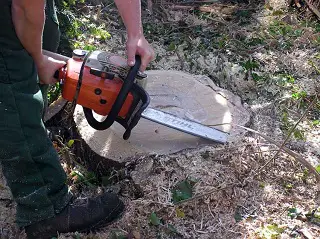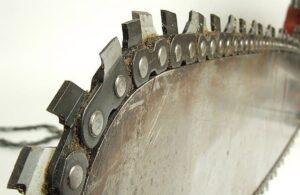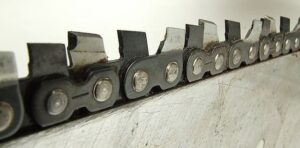As an Amazon Associate, this site earns commissions from qualifying purchases. For more information click here.
When a chainsaw cuts crookedly, you know something is wrong. The good news is you can easily find out the cause and fix it. Yes there is something amiss with your chainsaw if it cannot cut straight, but it is not a serious matter to really worry about. With a bit of patience you can make the blade cut properly again.
Crooked chainsaw cuts are usually caused by a bent bar, loose chain or an uneven top plate. Incorrect sharpening and worn out teeth can be become uneven and make it difficult to cut straight.
1. Not Sharpened Correctly
Sharpening the chain ensures consistent, smooth cuts. But unequal sharpening could result in uneven teeth. Because some teeth will be sharper than the others, the cuts will come out crooked.
This usually happens when you use a file guide to manually sharpen chains. Often one side gets sharpened a lot more than the other. This can happen to beginners who are sharpening a chainsaw chain for the first time.

There are two ways to fix this problem. First, make sure to sharpen both sides evenly. This is not as hard as it sounds. You just have to focus and ensure you sharpen the sides equally.
The other option is to use a grinder. Grinders are more expensive than a file guide, but you can fine tune the sharpening process so it is evenly applied to the teeth. If you prefer a file guide, you may employ a vice to help keep the sharpening even.
2. Chain is Too Loose or Too Tight
If the chain keeps coming off, the blade will not be able to cut straight. If the chain is too tight, it will not be able to move at all. If it does, it will not be smooth.
The solution is to fine tune the chain tension. Look for the chain adjustment screw and adjust the setting. A slight tweak can significantly loosen or tighten the chain so do this slowly. When you are happy with the result, tighten the bolts.
Try the chainsaw again and it should now cut straight. The key here is to adjust the tension in increments to avoid sudden changes. The Husqvarna 445 Gas Chainsaw is especially nice as it makes this kind of adjustment easy.
3. Worn Out Teeth
If the cutting teeth is worn out, they become ragged and you end up with uneven results. Dull teeth also responsible for poor cuts so sharpening is essential.
There are a couple of things you can do here. First, make sure there are no nails, rocks, stones and other objects that can damage the teeth. If the cutter gets jammed on any of these, some of the teeth could break off and leave it uneven.
Second, you have to sharpen the teeth regularly. Sharpen it with a file guide or grinder, it is your choice. What is important is the teeth come out even. If the teeth are broken or has gone over the sharpening mark, replace with a chain that is compatible with your chainsaw.
4. Chainsaw Bar is Bent
This is probably the easiest problem to spot. If you have been cutting with your chainsaw for a while, you should be able to tell if the bar is bent.
If the bar veers one way then it comes as no surprise why the cuts are not straight. However it is possible to fix this. If the nose can be replaced, you can flatten it again by hammering it on an iron block surface. After several hits from a hammer, check the nose. If it looks straight, try the chainsaw again.
This only works if the nose can be replaced separately. Otherwise you have to replace the chainsaw bar. Check your chainsaw operating manual to verify if the nose is replaceable or not.
5. Top Plate is Uneven
If you fixed the bar but the cuts are still crooked, the top plate might be uneven. If the top plate is not properly set up, the chainsaw teeth will produce uneven cuts.
To fix this, examine the plate. If one side is lengthier than the other, sharpen the longer one until the two are equal length. Make sure also that the angles match one another.
Sharpen slowly so you do not end up shaving too much metal off. When the plate sides are equal, try cutting with the chainsaw again.
Other Possible Reasons Why Chainsaws Cannot Cut Straight
The five reasons given above are the most common, and if your chainsaw is not cutting straight, it is probably one of those. But there are possibilities as well. If your chainsaw cannot run properly and none of the solutions given above works, try the following.
Wrong Depth Gauge
Chainsaws cut into wood at a specific depth per chain revolution. Usually this is set at 1/4 inch but it can vary by manufacturer.
If the depth is incorrect the saw may not be able to cut correctly. Consult your chainsaw operating instructions to find the depth.
Next you have to use a depth gauge and a file guide like the Husqvarna 5056981 to examine the chain. Set the depth gauge tool on the chain so the tool skips into the slot.
The top of the slot needs to be even with the tool. If it is too high, use the file guide to trim it. Repeat it with the rest of the teeth.
Check the Cutter Length
If you sharpened the chain and it cuts to one side, it means one side got sharpened more than the other. If the cut veers to the right for instance, the right cutter is cutting a bigger chunk of wood than the left.
To be sure, check the cutter length. The longer it is, the more sharpening has been done to it. Now that you know which got more sharpened, you can even it out.
Uneven Bar Rail or Grooves
If you sharpened the cutters properly, set the depth gauge right and the cuts are still crooked, look at the bar rail because it is probably uneven.
A worn out bar groove is another possibility. Just like with other chainsaw parts, the bar groove gets worn out after extensive use. When this happens, the chain could get loose and can no longer cut straight. This can be dangerous so you have to be careful when handling a chainsaw.
Hardware or Mechanical Failure
The last possibility is there is a mechanical or hardware failure. In most cases you can troubleshoot the chainsaw with the tips given here. But sometimes problems can occur that affect the internal components or mechanisms. If this happens, the best recourse is to take it to a repair shop.
How to Sharpen Chains to Prevent Crooked Cuts
When it is time to sharpen the chain, set it into a vice. This enables the bar to freely turn while being secure.
Use a file guide to rotate the chain, not your hand. Start with the tooth that is in the worst shape. Work the file guide on the tooth and count every stroke.
When the tooth is sharpened, work on the other teeth. Use the same number of strokes as you did on the first tooth. Doing this increases the chances all teeth wearing out simultaneously. This also means the cut should remain straight. Note: the more you sharpen a cutter, the shorter it becomes. Eventually it has to be replaced.
Tips on How to Keep Chainsaw Cuts Straight
While you can fix a crooked chainsaw cut, it is better to take preventive steps. Here are some things you can do to keep the saw cutting straight.
Flip the bar every time you clean the chainsaw so it wears out evenly. Note that this is preventive and will not repair a crooked cut. If the saw does not cut straight, you have to fix it.
If you are having trouble finding which side needs more sharpening, the sharper one has more space between the ends of its teeth.
When sharpening, hold the file guide so that it makes contact with the edge of the cutter. If it does not, you will just end up sharpening the lower area. If this happens, the chain will not be able to saw straight.

I love the outdoors and all the tools for maintaining gardens, yards and lawns. The only thing I am more passionate about is sharing what I know about garden and outdoor equipment.


